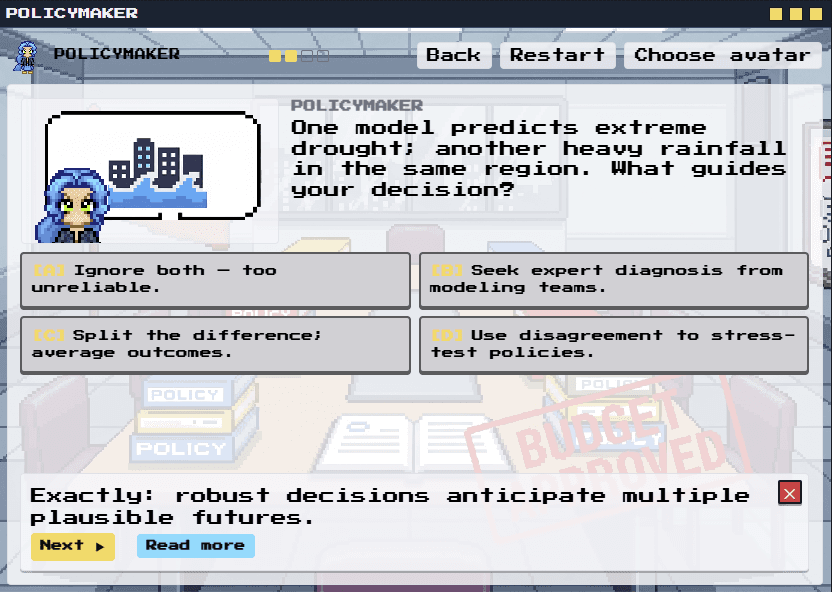Show, Don't Tell: Creative Elements That Make Academic Websites Memorable
Use interactive storytelling so visitors grasp why complex research matters in practice.
Key takeaways
- Use interactive elements to let visitors experience the core insight of your research.
- Map audiences first so every element speaks to the people who most need your work.
- Prototype lightweight games or quizzes that link directly to deeper resources and publications.
Academics often write, “My research is useful to...” but unless there is immediate evidence—or a vivid way to imagine how it might matter—those claims fall flat. A website can shoulder that storytelling work. Treat it like a teaching tool that lets people test-drive your ideas, not simply read a CV.
At Danlio Studio we helped a scholar who studies scientific uncertainty. His challenge: show that disagreement between scientists can actually strengthen public decisions. Instead of adding another paragraph, we designed a lightweight “choose your own adventure” interaction.
Turning research into an experience
One of our clients studies how scientific uncertainty works. To most people, uncertainty sounds like a problem; it suggests that science is unreliable. His research proves the opposite: uncertainty is an essential ingredient in generating new knowledge.
How do you convey that subtle point to different audiences? We designed a small choose-your-own-adventure game for his site. The game doesn’t just state the claim; it invites visitors to experience how scientific disagreement and error can improve decision-making.
Project highlight
A choose-your-own-adventure game that lets visitors experience how scientific uncertainty strengthens real-world outcomes.
Step 1: Define the audiences
The first question we asked the client was simple: Who should care about your research? He identified policymakers, city planners, journalists, and science students. That clarity let us tailor the storyline and vocabulary for each visitor segment.
Audience roster
 Policymakers:
Policymakers: Need stories that show how uncertainty informs better climate decisions.
 City planners:
City planners: Want proof that data disagreements can lead to resilient infrastructure choices.
 Journalists:
Journalists: Look for angles that translate nuance into headlines without sensationalism.
 Science students:
Science students: Benefit from interactive demos that connect theory to real-world stakes.
Visual note: pairing each persona with an avatar made it instantly clear that four distinct paths existed.
Tip for scholars
List three to five audiences who benefit from your work. Specificity sharpens your messaging and keeps features honest to your impact.
Step 2: Distill the core messages
With audiences in place we mapped what each already believed versus what they needed to learn. That gap informed the beats of the interaction and the copy supporting it.
- Science is often flawed and messy.
- Disagreement among scientists is not a weakness.
- Structured disagreement can strengthen real-world decisions.
Tip for scholars
Translate your research into two or three plain-language takeaways. Those become the “aha” moments you stage throughout the experience.
Step 3: Build scenarios and dialogue
From there, we created branching scenarios. Visitors picked an audience (say, journalist or policymaker), then answered questions that mirrored their real-world concerns. Each choice triggered a short response—like being in conversation with the scholar.
To deepen the experience, we layered in contextual “Read more” links pointing to accessible explainers and the scholar’s own publications. The game stayed streamlined while offering serious depth for people who wanted citations or classroom material.

Tip for scholars
Simulate the questions your audiences actually ask. Quizzes, games, sliders, and guided decision trees make abstract claims tangible.
Step 4: Build and deploy
Once the structure locked, we coded the game in JavaScript and embedded it directly into the site. The build followed the same principles we use on flagship projects: accessible markup, reusable components, and analytics hooks to watch how visitors engaged with each branch.
The client now uses the game in multiple contexts—on the homepage, during invited talks, and inside classroom workshops. It sparks curiosity immediately because audiences can play their way through the logic and see how disagreement fuels discovery.
See the prototype
Curious what this looks like in practice? Try the interactive game and experience how the branching logic plays out.
Why this works
Scholars teach and persuade. An interactive widget lets you do both at once. By guiding visitors through a scenario, you demonstrate expertise without declaring it. People leave having learned something from you—a far more memorable impression than a static biography.
Off-the-shelf templates rarely support this level of specificity. Tailored creative elements must align with your research questions, your audiences, and the way you prefer to teach. That’s where we partner closely with scholars: translating intellectual work into digital experiences that argue for themselves.
Ready to bring your research to life?
See how other scholars turned complex ideas into memorable digital experiences—or start a conversation about your own project today.
You might also like
Keep exploring thesis-led playbooks and case studies.